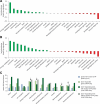Dual transcriptional activator and repressor roles of TBX20 regulate adult cardiac structure and function
- PMID: 22328084
- PMCID: PMC3335310
- DOI: 10.1093/hmg/dds034
Dual transcriptional activator and repressor roles of TBX20 regulate adult cardiac structure and function
Abstract
The ongoing requirement in adult heart for transcription factors with key roles in cardiac development is not well understood. We recently demonstrated that TBX20, a transcriptional regulator required for cardiac development, has key roles in the maintenance of functional and structural phenotypes in adult mouse heart. Conditional ablation of Tbx20 in adult cardiomyocytes leads to a rapid onset and progression of heart failure, with prominent conduction and contractility phenotypes that lead to death. Here we describe a more comprehensive molecular characterization of the functions of TBX20 in adult mouse heart. Coupling genome-wide chromatin immunoprecipitation and transcriptome analyses (RNA-Seq), we identified a subset of genes that change expression in Tbx20 adult cardiomyocyte-specific knockout hearts which are direct downstream targets of TBX20. This analysis revealed a dual role for TBX20 as both a transcriptional activator and a repressor, and that each of these functions regulates genes with very specialized and distinct molecular roles. We also show how TBX20 binds to its targets genome-wide in a context-dependent manner, using various cohorts of co-factors to either promote or repress distinct genetic programs within adult heart. Our integrative approach has uncovered several novel aspects of TBX20 and T-box protein function within adult heart. Sequencing data accession number (http://www.ncbi.nlm.nih.gov/geo): GSE30943.
Figures





Similar articles
-
Tbx20 regulates a genetic program essential to adult mouse cardiomyocyte function.J Clin Invest. 2011 Dec;121(12):4640-54. doi: 10.1172/JCI59472. Epub 2011 Nov 14. J Clin Invest. 2011. PMID: 22080862 Free PMC article.
-
Tbx20 Is Required in Mid-Gestation Cardiomyocytes and Plays a Central Role in Atrial Development.Circ Res. 2018 Aug 3;123(4):428-442. doi: 10.1161/CIRCRESAHA.118.311339. Circ Res. 2018. PMID: 29903739 Free PMC article.
-
TBX20 Improves Contractility and Mitochondrial Function During Direct Human Cardiac Reprogramming.Circulation. 2022 Nov 15;146(20):1518-1536. doi: 10.1161/CIRCULATIONAHA.122.059713. Epub 2022 Sep 14. Circulation. 2022. PMID: 36102189 Free PMC article.
-
Tbx20, Smads, and the atrioventricular canal.Trends Cardiovasc Med. 2010 May;20(4):109-14. doi: 10.1016/j.tcm.2010.09.004. Trends Cardiovasc Med. 2010. PMID: 21335279 Review.
-
Probing the polygenic basis of cardiomyopathies in Drosophila.J Cell Mol Med. 2012 May;16(5):972-7. doi: 10.1111/j.1582-4934.2012.01529.x. J Cell Mol Med. 2012. PMID: 22268758 Free PMC article. Review.
Cited by
-
PRDM16 Is a Compact Myocardium-Enriched Transcription Factor Required to Maintain Compact Myocardial Cardiomyocyte Identity in Left Ventricle.Circulation. 2022 Feb 22;145(8):586-602. doi: 10.1161/CIRCULATIONAHA.121.056666. Epub 2021 Dec 17. Circulation. 2022. PMID: 34915728 Free PMC article.
-
Beyond the ENCODE project: using genomics and epigenomics strategies to study enhancer evolution.Philos Trans R Soc Lond B Biol Sci. 2013 Nov 11;368(1632):20130022. doi: 10.1098/rstb.2013.0022. Print 2013 Dec 19. Philos Trans R Soc Lond B Biol Sci. 2013. PMID: 24218635 Free PMC article. Review.
-
Dual specificity phosphatase 4 mediates cardiomyopathy caused by lamin A/C (LMNA) gene mutation.J Biol Chem. 2012 Nov 23;287(48):40513-24. doi: 10.1074/jbc.M112.404541. Epub 2012 Oct 9. J Biol Chem. 2012. PMID: 23048029 Free PMC article.
-
Transcriptomic Signatures of Postnatal and Adult Intrinsically Photosensitive Ganglion Cells.eNeuro. 2019 Aug 26;6(4):ENEURO.0022-19.2019. doi: 10.1523/ENEURO.0022-19.2019. Print 2019 Jul/Aug. eNeuro. 2019. PMID: 31387875 Free PMC article.
-
A promoter interaction map for cardiovascular disease genetics.Elife. 2018 Jul 10;7:e35788. doi: 10.7554/eLife.35788. Elife. 2018. PMID: 29988018 Free PMC article.
References
-
- Singh M.K., Christoffels V.M., Dias J.M., Trowe M.-O., Petry M., Schuster-Gossler K., Bürger A., Ericson J., Kispert A. Tbx20 is essential for cardiac chamber differentiation and repression of Tbx2. Development. 2005;132:2697–2707. - PubMed
-
- Stennard F.A., Costa M.W., Lai D., Biben C., Furtado M.B., Solloway M.J., McCulley D.J., Leimena C., Preis J.I., Dunwoodie S.L., et al. Murine T-box transcription factor Tbx20 acts as a repressor during heart development, and is essential for adult heart integrity, function and adaptation. Development. 2005;132:2451–2462. - PubMed
-
- Takeuchi J.K., Mileikovskaia M., Koshiba-Takeuchi K., Heidt A.B., Mori A.D., Arruda E.P., Gertsenstein M., Georges R., Davidson L., Mo R., et al. Tbx20 dose-dependently regulates transcription factor networks required for mouse heart and motoneuron development. Development. 2005;132:2463–2474. - PubMed
-
- Liu C., Shen A., Li X., Jiao W., Zhang X., Li Z. T-box transcription factor TBX20 mutations in Chinese patients with congenital heart disease. Eur. J. Med. Genet. 2008;51:580–587. - PubMed
Publication types
MeSH terms
Substances
Associated data
- Actions
Grants and funding
LinkOut - more resources
Full Text Sources
Molecular Biology Databases

